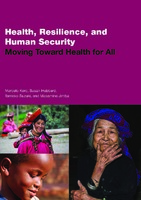Korc, Marcelo; Hubbard, Susan; Suzuki, Tomoko; Jimba, Masamine
Japan Center for International Exchange and Pan American Health Organization
Published online: May 2016
 The purpose of this document is to explain to experts in the health and development fields what a human security approach is and show how it can be applied in an attempt to put individuals and communities on a path toward achieving a virtuous cycle of good health, wellbeing, and resilience. In particular, the document focuses on how the human security approach addresses the linkages among different sources of health threats and ensures that interventions are integrated so as to build and sustain health resilience at the individual, community, and institutional levels as a path toward health for all through universal health coverage (UHC).2 It also focuses on how human security can help translate health gains into improvements in wellbeing on a larger scale. In other words, an emphasis on human security can help us to move beyond focusing on survival to focusing on livelihoods, wellbeing, and dignity. Policymakers and funders will benefit from a clearer understanding not only of the added value of human security to health concerns but also of the opportunities that exist to integrate principles of human security into both new and existing health initiatives. This document will also allow health and development experts to make the best use of the human security approach in their activities. Most public health and development practitioners are aware of—and are likely using—one or more aspects of the approach. But they generally are unfamiliar with the full picture, so they may not be consciously adopting the approach in a comprehensive manner. In other words, the individual components of human security approaches are not new, and many of them are found in existing health programs. In fact, research conducted during the preparation of this report found that many health interventions include components of the human security approach even though they do not necessarily use the term “human security” or even connect the components with the approach. It is our hope that this document can be used to accelerate the process of integrating human security components into new and existing activities by allowing readers to learn from the experience of their colleagues in the field, thus accelerating the progress toward achieving the freedom from fear, the freedom from want, and the freedom to live in dignity for one and all.
The purpose of this document is to explain to experts in the health and development fields what a human security approach is and show how it can be applied in an attempt to put individuals and communities on a path toward achieving a virtuous cycle of good health, wellbeing, and resilience. In particular, the document focuses on how the human security approach addresses the linkages among different sources of health threats and ensures that interventions are integrated so as to build and sustain health resilience at the individual, community, and institutional levels as a path toward health for all through universal health coverage (UHC).2 It also focuses on how human security can help translate health gains into improvements in wellbeing on a larger scale. In other words, an emphasis on human security can help us to move beyond focusing on survival to focusing on livelihoods, wellbeing, and dignity. Policymakers and funders will benefit from a clearer understanding not only of the added value of human security to health concerns but also of the opportunities that exist to integrate principles of human security into both new and existing health initiatives. This document will also allow health and development experts to make the best use of the human security approach in their activities. Most public health and development practitioners are aware of—and are likely using—one or more aspects of the approach. But they generally are unfamiliar with the full picture, so they may not be consciously adopting the approach in a comprehensive manner. In other words, the individual components of human security approaches are not new, and many of them are found in existing health programs. In fact, research conducted during the preparation of this report found that many health interventions include components of the human security approach even though they do not necessarily use the term “human security” or even connect the components with the approach. It is our hope that this document can be used to accelerate the process of integrating human security components into new and existing activities by allowing readers to learn from the experience of their colleagues in the field, thus accelerating the progress toward achieving the freedom from fear, the freedom from want, and the freedom to live in dignity for one and all.
How to obtain this publication (English) – click here







